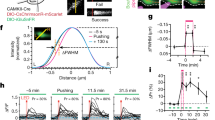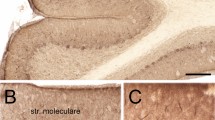Summary
In earlier ultrastructural studies of the supraoptic nucleus in adult rats we noted “free” and incompletely covered postsynaptic densities (collectively referred to here as vacant postsynaptic densities) on dendritic shafts. Free postsynaptic densities have been reported in other parts of the central nervous system of normal rodents. We investigated the possibility that physiological activation of the supraoptic cells, which produces changes in many aspects of their morphology, would alter the incidence of the free or incompletely covered postsynaptic densities on dendrites in the supraoptic basal dendritic zone. The cells of the supraoptic nucleus are activated to increase cell firing and secretion of oxytocin and/or vasopressin in response to dehydration, gestation, and lactation. We have examined: (i) untreated virgin females; (ii) untreated males; (iii) 24 h water-deprived males; (iv) prepartum (21st day of gestation) females; (v) postpartum females (on the day of parturition); (vi) lactating females (14 days of suckling); (vii) mothers 10 days after weaning their pups; (viii) females given 2% saline to drink (dehydrated) for 10 days; and females or males given 2% saline to drink for 10 days, then given tap water for (ix) 2 or (x) 5 weeks to allow rehydration. Only long-term activation of the supraoptic nucleus by lactation or by drinking saline for 10 days brought about significant decreases in the percentage of dendrites with vacant postsynaptic densities. These densities did not reappear in saline treated rats which had been rehydrated for 2 weeks, but did return in both the 5-week rehydration and the 10-day postweaning groups. Short-term activation of the supraoptic nucleus, such as occurs at parturition or in acute dehydration, did not affect the vacant postsynaptic densities. Analysis of semiserial thin sections indicated that presynaptic elements facing the incompletely covered postsynaptic densities contain predominantly clear round vesicles and also that apparently free postsynaptic densities were usually at least partially contacted by a presynaptic ending in adjacent sections.
Similar content being viewed by others
References
Armstrong WE, Schöler J, McNeil TH (1982) Immunocytochemical, Golgi and electron microscopic characterization of putative dendrites in the ventral glial lamina of the rat supraoptic nucleus. Neuroscience 7:679–694
Cardasis CA, Padykula HA (1981) Ultrastructural evidence indicating reorganization at the neuromuscular junction in the normal rat soleus muscle. Anat Rec 200:41–59
Cotman CW, Kelly PT (1980) Macromolecular architecture of CNS synapses. In: Cotman CW, Poste G, Nicholson GL (eds) Cell Surface Reviews. Elsevier, Amsterdam, pp 505–533
Desmond NL, Levy WB (1983) Synaptic correlates of associative potentiation/depression: an ultrastructural study in the hippocampus. Brain Res 265:21–30
Desmond NL, Levy WB (1985) Postsynaptic density surface area per synapse increases with long-term potentiation. Anat Rec 211:52A
Gray EG, Hamlyn LH (1963) Electron microscopy of experimental degeneration in the avian optic tectum. J Anat 309–316
Hatten G, Perlmutter LS, Salm AK, Tweedle CD (1984) Dynamic neuronal glial interactions in hypothalamus and pituitary: implications for control of hormone synthesis and release. Peptides 5:(Suppl 1) 121–138
Hatton GI, Tweedle CD (1982) Magnocellular neuropeptidergic neurons in hypothalamus: increases in membrane apposition and number of specialized synapses from pregnancy to lactation. Brain Res Bull 8:197–204
Hinds JW, Hinds PL (1976) Synapse formation in the mouse olfactory bulb. II. Morphogenesis. J Comp Neurol 169:41–62
Matthews DE, Cotman C, Lynch G (1976) An electron microscopic study of lesion-induced synaptogenesis in the dentate gyrus of the adult rat. II. Reappearance of morphologically normal synaptic contacts. Brain Res 115:23–41
Perlmutter LS, Tweedle CD, Hatton GI (1984) Neuron/glial plasticity in the supraoptic dendritic zone: Dendritic bundling and double synapse formation at parturition. Neuroscience 13:769–779
Perlmutter LS, Tweedle CD, Hatton GI (1985) Neuronal/glial plasticity in the supraoptic dendritic zone in response to acute and chronic dehydration. Brain Res 361:225–232
Peters A, Palay S, Webster de F (1976) The fine structure of the nervous system. Saunders, Philadelphia
Pinching AJ (1969) Persistence of postsynaptic membrane thickenings after degeneration of olfactory nerves. Brain Res 16:277–281
Prü ELP, Briceno RVM (1973) An unusual relationship between glial cells and neuronal dendrites in olfactory bulbs of Desmodus rotundus. Brain Res 36:404–408
Raisman G, Field PM, Ostberg AJC, Iversen LL, Zigmond RE (1974) A quantitative ultrastructural and biochemical analysis of the process of reinnervation of the superior cervical ganglion in the adult rat. Brain Res 71:1–16
Sotelo C (1973) Permanence and fate of paramembranous synaptic specializations in mutants and experimental animals. Brain Res 62:345–351
Spacek J (1982) Free postsynaptic-like densities in normal adult brain: their ocurrence, distribution, structure and association with subsurface cisternae. J Neurocytol 11:693–706
Spacek J, Lieberman AR (1973) Distribution of synaptic types on thalamocortical projection neurons of rat ventro-basal thalamus. J Anat 117:212–213
Spacek J, Lieberman AR (1974) Ultrastructure and three-dimensional organization of synaptic glomeruli in rat somatosensory thalamus. J Anat 117:487–516
Tweedle CD, Hatton GI (1984) Synapse formation and disappearance in adult rat supraoptic nucleus during different hydration states. Brain Res 309:373–376
Wernig A, Carmody JJ, Anzil AP, Hansert E, Marciniak M, Zucker H (1984) Continual nerve sprouting with features of synapse remodeling in soleus muscles of adult mice. Neuroscience 11:241–253
Westrum LE (1969) Electron microscopy of the degeneration of the lateral olfactory tract and prepyriform cortex of the rat. Z Zellforsch 98:157–187
Westrum LE (1975) Electron microscopy of synaptic structures in olfactory cortex of early postnatal rats. J Neurocytol 4:713–732
Wolff JR (1978) Ontogenetic aspects of cortical architecture: lamination. In: Brazier MAB, Petsche H (eds) Architectonics of the cerebral cortex. Raven Press, New York, pp 159–173
Yulis CR, Peruzzo B, Rodriguez EM (1984) Immunocytochemistry and ultrastructure of the neuropil located ventral to the rat supraoptic nucleus. Cell Tissue Res 236:171–180
Author information
Authors and Affiliations
Rights and permissions
About this article
Cite this article
Tweedle, C.D., Hatton, G.I. Vacant postsynaptic densities on supraoptic dendrites of adult rats diminish in number with chronic stimuli. Cell Tissue Res. 245, 37–41 (1986). https://doi.org/10.1007/BF00218084
Accepted:
Issue Date:
DOI: https://doi.org/10.1007/BF00218084




